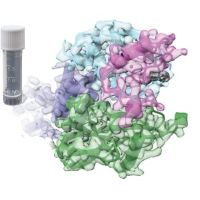Specification
| Organism | Homo sapiens (Human) |
| Expression Host | E.coli |
| Tag Info | N-terminal GST-tagged |
| Purity | Greater than 85% by SDS-PAGE |
| Uniprot ID | Q8IUQ4 |
| Gene Names | SIAH1 |
| Alternative Names | Seven in absentia homolog 1 |
| Expression Region | Full Length of Isoform 2(1-313aa ) |
| Molecular Weight | 61.6 kDa |
| Protein Sequence | MTGKATPPSLYSWRGVLFTCLPAARTRKRKEMSRQTATALPTGTSKCPPSQRVPALTGTTASNNDLASLFECPVCFDYVLPPILQCQSGHLVCSNCRPKLTCCPTCRGPLGSIRNLAMEKVANSVLFPCKYASSGCEITLPHTEKADHEELCEFRPYSCPCPGASCKWQGSLDAVMPHLMHQHKSITTLQGEDIVFLATDINLPGAVDWVMMQSCFGFHFMLVLEKQEKYDGHQQFFAIVQLIGTRKQAENFAYRLELNGHRRRLTWEATPRSIHEGIATAIMNSDCLVFDTSIAQLFAENGNLGINVTISMC |
| Form | Liquid or Lyophilization |
| Buffer | The default storage buffer is Tris/PBS-based buffer, 5%-50% glycerol if the delivery form is liquid. The lyophilization buffer is Tris/PBS-based buffer, 6% Trehalose, pH 8.0 if the delivery form is lyophilized powder. Please contact us if you have any special requirment. |
| Reconstitution | Please reconstitute protein in deionized sterile water and we recommend that briefly centrifuge thevial prior to opening the vial .We recommend aliquot for long-term storage at -20℃/-80℃. |
Background
| Relevance | E3 ubiquitin-protein ligase that mediates ubiquitination and subsequent proteasomal degradation of target proteins. E3 ubiquitin ligases accept ubiquitin from an E2 ubiquitin-conjugating enzyme in the form of a thioester and then directly transfers the ubiquitin to targeted substrates. Mediates E3 ubiquitin ligase activity either through direct binding to substrates or by functioning as the essential RING domain subunit of larger E3 complexes. Triggers the ubiquitin-mediated degradation of many substrates, including proteins involved in transcription regulation (ELL2, MYB, POU2AF1, PML and RBBP8), a cell surface receptor (DCC), the cell-surface receptor-type tyrosine kinase FLT3, the cytoplasmic signal transduction molecules (KLF10/TIEG1 and NUMB), an antiapoptotic protein (BAG1), a microtubule motor protein (KIF22), a protein involved in synaptic vesicle function in neurons (SYP), a structural protein (CTNNB1) and SNCAIP. Confers constitutive instability to HIPK2 through proteasomal degradation. It is thereby involved in many cellular processes such as apoptosis, tumor suppression, cell cycle, axon guidance, transcription regulation, spermatogenesis and TNF-alpha signaling. Has some overlapping function with SIAH2. Induces apoptosis in cooperation with PEG3. Upon nitric oxid (NO) generation that follows apoptotic stimulation, interacts with S-nitrosylated GAPDH, mediating the translocation of GAPDH to the nucleus. GAPDH acts as a stabilizer of SIAH1, facilitating the degradation of nuclear proteins. |
| Involvement in Disease | |
| Subcellular Location | Cytoplasm, Nucleus |
| Protein Families | SINA (Seven in absentia) family |
| Tissue Specificity | SIAH1 |
QC Data
| Note | Please contact us for QC Data |
| Product Image (Reference Only) |  |

